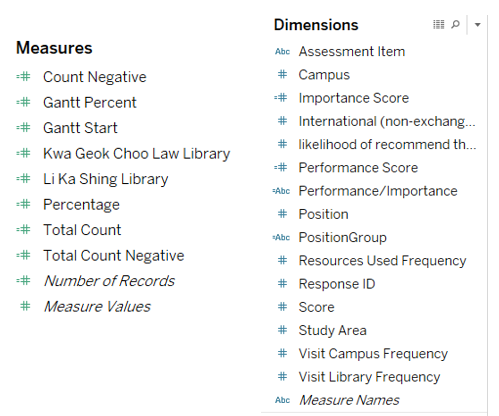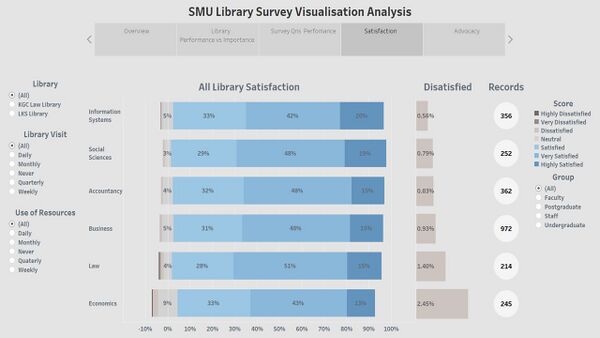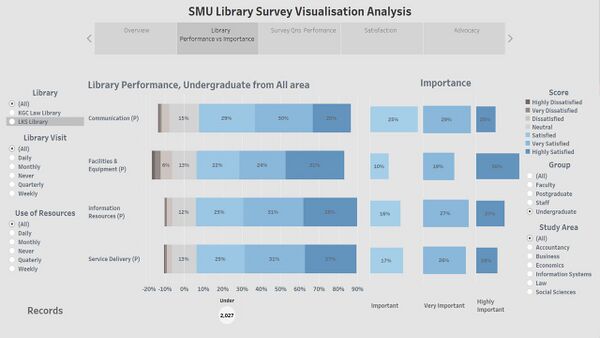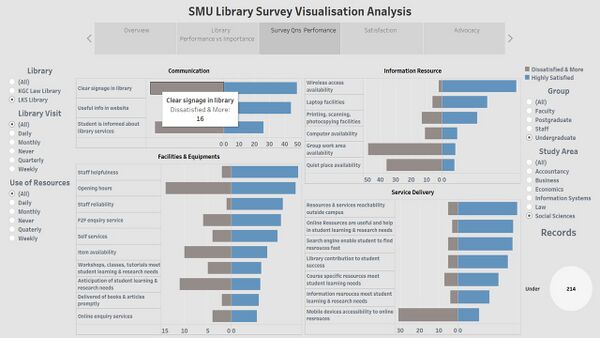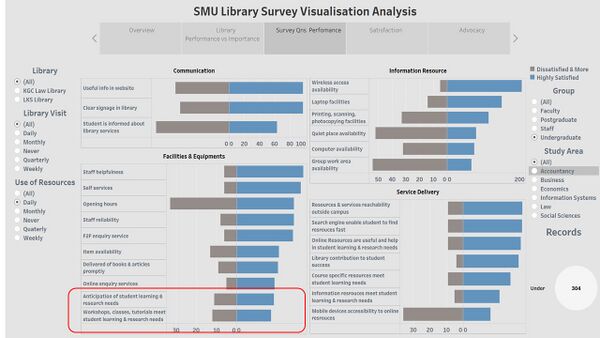SMU Library Survey
Background
Every two years, SMU Libraries conduct a comprehensive survey in which faculty, students and staff have the opportunity to rate various aspects of SMU library's services. The survey provides SMU libraries with input to help enhance existing services and to anticipate emerging needs of SMU faculty, students and staff.
Objectives
With the feedback obtain from the survey, I am tasked to utilize visual analytics approach to reveal the level of services provided by SMU libraries as perceived by:
- the undergraduate students,
- the postgraduate students,
- the faculty,
- the staff.
Summarising Data Set & Planning for Visualisation
The Dataset being used in this visualisation is from SMU Library: 2018 Survey Results. Can be found here
| Dashboard
|
Purpose
|
Variable Require
|
Measurement
|
| Overview
|
This will be the home dashboard of the visualisation which summarise the entire processed data. It is interactive as viewer able to toggle filtering simply by selecting the field. This include:
- Total number of respondents and the background of the respondents
- Total respondents reponding to Li Ka Shing and Kwa Geok Choo Law Libraries respectively
- Total respondents from different position such as Undergraduate/ Graduate / Staff/ Faculty
- Total respondents from different study area such as Accountancy/ Business/ Economics
|
StudyArea, ResponseID, Position
|
Number of respondents
|
| Importance VS Performance
|
This dashboard will provide an overview of respondents' response to libraries service. Rating their importancy and performance for different aspect. Presenting 1 being the lowest to 7 the highest. This will be a interactive interface where viewer able to toggle filtering to narrow down the details such as filtering through which library, which study area and their group position
|
Assessment Item, Score, HowOftenL, HowOftenW
|
Distribution of score rating 1 - 7, Number of respondents
|
| Summary
|
This dashboard will provide an summary of the analysed data where viewer able to compare satisfactory between study area to on the general scale. This could acts as a medium for library to target specific study area to cater to their needs. It also allow viewer to see respondents relationship towards recommending to others based on their overall satisfactory
|
StudyArea, Number of Records, likelihood of recommend the library service to others
|
- Satisfactory difference between study area
- Correlation between people who are satisfied and people who likely to recommend to others
|
Hand-drawn visualisation
Overview
Chart1:
Chart2:
Importance vs Performance
For performance and important (chart 3&4):
Summary
Chart 5:
Chart 6:
Data preparation
| Screenshot
|
Steps Taken
|
|

|
Data Preparation: Hiding
- Hide column NA1-NA26 and comment by right clicking and select hide
|
|
|
Data Preparation: Pivot
- Select column from I01-P27
- Right click and select pivot
|
|
|
Data Preparation: Renaming
Rename the column heading:
- 'Pivot Field Names' to 'Assessment Item'
- 'Pivot Field Values' to 'Score'
- 'How Often L' to 'Visit Library Frequency'
- 'How Often C' to 'Visit Campus Frequency'
- 'How Often W' to 'Resources Used Frequency'
- 'Nps1' to 'likelihood of recommend the library service'
|
|
|
Edit Alias for fields
- Right click the attribute
- Select Aliases
- Change the value(Alias)
- Change for Position, Study Area,Campus, Frequency
|
|
|
New calculated field and set
- Gannt percent, Gannt start, count negative, total count negative, percentage, total count for creating divergent chart in Important Vs Performance Dashboard.
- Kwa Geok Choo Law Library & Li Ka Shing Library for creating pyramid chart in Overview Dashboard.
- Performance Score and Important Score were use for Important Vs Performance Dashboard to show the meaning of the legend
- PositionGroup were use to group position together for filtering and for Overview Dashboard.
|
Interactive Visualization
The interactive visualization can be accessed
here:https://public.tableau.com/profile/neo.tee.yong#!/vizhome/assignment3_15842852167560/LibrarySurvery2018
Overview Dashboard
Overview dashboard.This dashboard depicts a pyramid chart with Kwa Geok Choo Law and Li Ka Shing Libraries. It indicates the no. of respondents with interactivities from group, library visit, use of resources, campus visit and student. Overview page allow user to examine the no. of respondents from KGC Law and LKS libraries with the mentioned interactivities.
Library Performance vs Importance
Library Performance vs Importance dashboard. This dashboard shows a divergent chart (Library Performance) as the main visualisation of how well the library performed in 4 of the segments – Communication, Facilities & Equipment, Information Resources and Service Delivery. The score ratings were replaced into 1 - Highly Dissatisfied, 2 – Very Dissatisfied, 3- Dissatisfied, 4 – Neutral, 5 – Satisfied, 6 – Very Satisfied, 7 – Highly Satisfied. Then an indication (Importance) shows percentage of respondents’ thoughts about the importance of the segments, by 5 – important, 6 – very important, 7 –highly important, matching the colour schemes of percentage responds in satisfied, very satisfied and highly satisfied. Lastly, another indication (records) defined the no. of respondents who answered the questions in each of the segments. In conclusions, group, study area, library, library visit, use of resources filtering will be use in all dashboards as main indicators to identify patterns and anomalies. The creativity of this dashboard allows user to compare library performance in the segments against respondents’ thoughts of how important each of the segments is.
Survey Qns Performance
Survey Qns Performance dashboard. This dashboard shows 4 pyramid charts of each library performance segments – communication, facilities & equipment, information resources and service delivery. Moreover, it consists of all questions asked and responds. The responds are categorised into highly satisfied against dissatisfied & more (dissatisfied, very dissatisfied and highly dissatisfied). This dashboard aid user to identify specific areas to improve and maintain based on the 4 broader segments. Only highly satisfied score was measure and compare as that is what every business, in this case the library’s goal. Vice versa, to convert dissatisfaction segment to satisfaction.
Satisfaction
Satisfaction dashboard. This dashboard shows a divergent chart of respondents’ overall satisfaction by study areas with their respective records.
Advocacy
Advocacy dashboard.This dashboard presents a divergent chart of respondents’ library advocacy by study areas with their respective net promoter scores and records.
Definition for NPS:
If Is negative – higher no. of dissatisfied respondents than satisfied respondents.
0 – 30, there is room for improvement.
30-70, doing great.
Above 70, library advocates.
Findings
Undergraduate
| S/N
|
screen shot
|
Insight and Significance
|
| 1
|
|
Library Performance vs Importance
- 2,027 respondents from the undergraduate.In general, more than 75% of the undergraduate are satisfied and more than satisfied in library performance of the 4 segments – communication, facilities & equipment, information resources and service delivery. Out of the 3 satisfied ratings, very satisfied have the most respondents except for facilities & equipment.
- Comparing with importance:
1.Communication and service delivery are the more consistent segments between their performance and importance. For example, communication performance satisfied metrics were 29%, 30%, 20% while the importance were 25%, 29%, 25%. Whereas, service delivery segment is moderate.
2.However, facilities & equipment segment contribute to bigger gap such as more than 25% difference between their performance and importance in their highly satisfied ratings. Moreover, this segment shows more respondents that are dissatisfied in overall.
|
| 2
|
|
- 328 undergraduates from accountancy show a 2% higher highly satisfied as compare to highly important in service delivery segment, differentiating this category of undergraduate from the rest.
|
| 3
|
|
- 22 law undergraduate that visit library and uses the resources daily has 7% highly satisfied performance than highly importance in the communication segment. Communication segment had performed fairly well in this set of filter.
|
| 4
|
|
- 229 Undergraduate that visit the library monthly has 3% highly satisfied performance than highly importance in the service delivery segment. Therefore, from previous insight, SMU Library could conduct a more detail interview with undergraduate from accountancy that visit the library monthly about the strength of delivery service quality and make improvement.
|
| 5
|
|
Survey Qns performance
Communication
1.Student is informed about library services has the poorest performance in communication platform with 157 dissatisfied, more than dissatisfied and 281 highly satisfied votes.
Facilities & Equipment
1.Library opening hours has the most dissatisfied & more and highly satisfied proportion of ratings.
2.Staff helpfulness, reliability, F2F service and self service are doing well in their performances, with less 50 dissatisfied & more and more than 500 highly satisfied ratings respectively.
3.Item availability, online enquiry services and delivered of books & article promptly are doing moderately well with 80, 52, 54 dissatisfied and more, 393 338, 309 highly satisfied ratings respectively.
4.Anticipation of student learning & research needs and workshops, classes and tutorial meet student research and learning need have the poorest performance in facilities & equipment segment with 111,117 dissatisfied and more, 316 and 286 highly satisfied ratings respectively.
Information Resources
1.Wireless accessibility performed the best in information resources. Whereas, quiet place and group work area availability were the worse with 342, 431 dissatisfied and more, 332, 286 highly satisfied ratings respectively.
Service Delivery
2.All the aspect in service delivery segment perform relatively well except for mobile devices accessibility to library online resources with 240 dissatisfied & more, 314 highly satisfied votes.
|
| 6
|
|
- Undergraduate from law that visit KGC law library had a different opinion on ‘opening hours’ in facilities & equipment segment as it is not their top choice in highly satisfied, instead it is one of the worse performing in facilities & equipment segment. Moreover, ‘printing, scanning, photocopying facilities’ is the top dissatisfaction in information resource segment. Therefore, SMU library may consider improving areas in opening hours and facilities of law library.
|
| 7
|
|
- Undergraduate from social sciences that visit LKS library had different opinions about clear signage in library as it is the highest dissatisfaction in communication segment, contradicting from all study area.
|
| 8
|
|
- Undergraduate that uses library resources daily have much smaller dissatisfaction in ‘anticipating of student learning & research needs’ and ‘workshops, classes, tutorial meet student learning & research needs’ as compare to the rest of the undergraduate. Hence, undergraduate that uses library resources daily might be better gauge for these 2 areas in facilities & equipment as they were the one that fully experience faculties & equipment frequently.
|
| 9
|
|
Satisfaction
- Overall library satisfaction of the undergraduate are skewed towards satisfactory side with very satisfied metrics having the majority votes.Satisfaction is within 28 – 35%, very satisfied is within 43% - 52%, highly satisfied is within 10% - 18%, neutral is within 2% -9%
|
| 10
|
|
Advocacy
- Overall library advocacy of the undergraduate are skewed towards passive and promoter with small gap between these parameters. SMU libraries are in between room for improvement and doing great for their NPS aspect.
|
Reference
<ref>https://www.datarevelations.com/resources/visualizing-net-promoter-score-data/<ref>
<ref>https://www.datarevelations.com/resources/rethinkingdivergent/<ref>
<ref>https://www.datarevelations.com/resources/got-likert-data-neutrals/<ref>
<ref>https://blog.hubspot.com/service/how-to-calculate-nps<ref>
<ref>https://www.udemy.com/course/tableau10-advanced/<ref>
Prof week 6 class exercise on divergent chart









